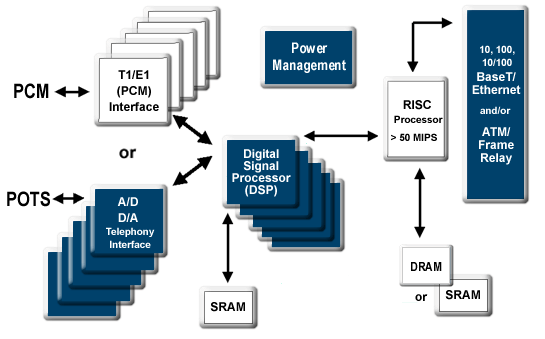![]() Digital Signal
Processing (DSP) is one of the fastest growing fields of
technology and computer science in the world, with typically a
growth rate in excess of 30%. The growth of the computer industry
has affected every corner of daily life and everyone is aware of
this effect. In today's western world almost everyone uses DSPs
in their everyday life, but unlike users of PCs almost no one
knows that they are using DSPs. Digital Signal Processors (DSPs)
are special purpose microprocessors and they are used in every
form of electronic product, from mobile phones and CD players to
the automotive industry; medical imaging systems to the
electronic battlefield and from dishwashers to satellites.
Digital Signal
Processing (DSP) is one of the fastest growing fields of
technology and computer science in the world, with typically a
growth rate in excess of 30%. The growth of the computer industry
has affected every corner of daily life and everyone is aware of
this effect. In today's western world almost everyone uses DSPs
in their everyday life, but unlike users of PCs almost no one
knows that they are using DSPs. Digital Signal Processors (DSPs)
are special purpose microprocessors and they are used in every
form of electronic product, from mobile phones and CD players to
the automotive industry; medical imaging systems to the
electronic battlefield and from dishwashers to satellites.
![]() DSP is all
about analysing and processing real-world or analogue
signals - the kind that humans interact with, for example speech.
These signals are converted to a format that the computers can
understand (digital) and then they are processed. The following
diagram shows graphically the typical component parts of a DSP
system.
DSP is all
about analysing and processing real-world or analogue
signals - the kind that humans interact with, for example speech.
These signals are converted to a format that the computers can
understand (digital) and then they are processed. The following
diagram shows graphically the typical component parts of a DSP
system.
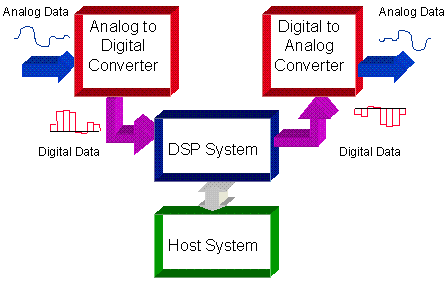
![]() In order to
process analog signals with digital computers, they must first be
converted to digital using analog to digital converters.
Similarly the digital signals must be converted back to analog
for them to be used outside the computer. The following diagram
shows this process.
In order to
process analog signals with digital computers, they must first be
converted to digital using analog to digital converters.
Similarly the digital signals must be converted back to analog
for them to be used outside the computer. The following diagram
shows this process.

![]() The diagram
shows the representation of a real-world analog signal in
blue and the digital representation of it in red. You will notice
that the red line only matches the blue line at discrete points
and these are called the sampling points. It is very important to
take enough samples of the input so that it can be faithfully
represented. The number of samples taken in one second is
referred to as the sampling rate and a good rule-of-thumb is
"the higher the sampling rate, the higher the cost of the
system".
The diagram
shows the representation of a real-world analog signal in
blue and the digital representation of it in red. You will notice
that the red line only matches the blue line at discrete points
and these are called the sampling points. It is very important to
take enough samples of the input so that it can be faithfully
represented. The number of samples taken in one second is
referred to as the sampling rate and a good rule-of-thumb is
"the higher the sampling rate, the higher the cost of the
system".
![]() There are many
reasons why we process these analog signals in the digital world
(or domain) but these can all be reduced to two primary reasons,
which are :
There are many
reasons why we process these analog signals in the digital world
(or domain) but these can all be reduced to two primary reasons,
which are :
Cost - DSP systems are almost always cheaper than analog.
Functionality - DSP systems can perform many operations that are impossible in the analog world.
Copyright © 1999, Numerix Ltd. Permission is granted to create WWW pointers to this document. All other rights reserved. All trademarks acknowledged.
Digital VCR
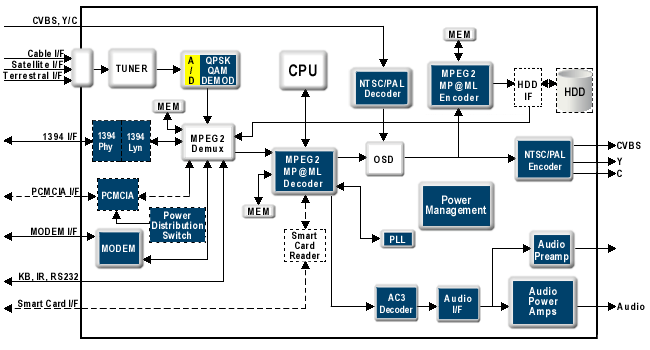
MPEG (pronounced M-peg), which stands for Moving Picture Experts Group, is the name of family of standards used for coding audio-visual information (e.g., movies, video, music) in a digital compressed format.
The major advantage of MPEG compared to other video and audio coding formats is that MPEG files are much smaller for the same quality. This is because MPEG uses very sophisticated compression techniques.
Digital Cell Phone
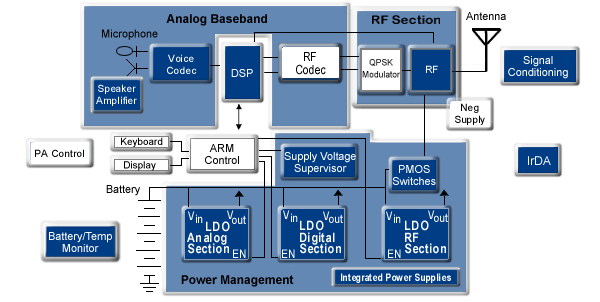
The diagrams below illustrate a typical implementation of QPSK:
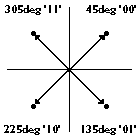

The figure shows each possible pair of data bits is represented by a different phase angle and figure 2 shows and example of a QPSK waveform. Because of QPSK, data rates are quoted in Symbol Rate rather than bit rate. In the case of QPSK modulation, the bit rate is twice high as the symbol rate. For example an SR of 20MS/s (20 mega-symbols) means 40Mb/s (40 mega-bits per second).
Voice Over Internet
